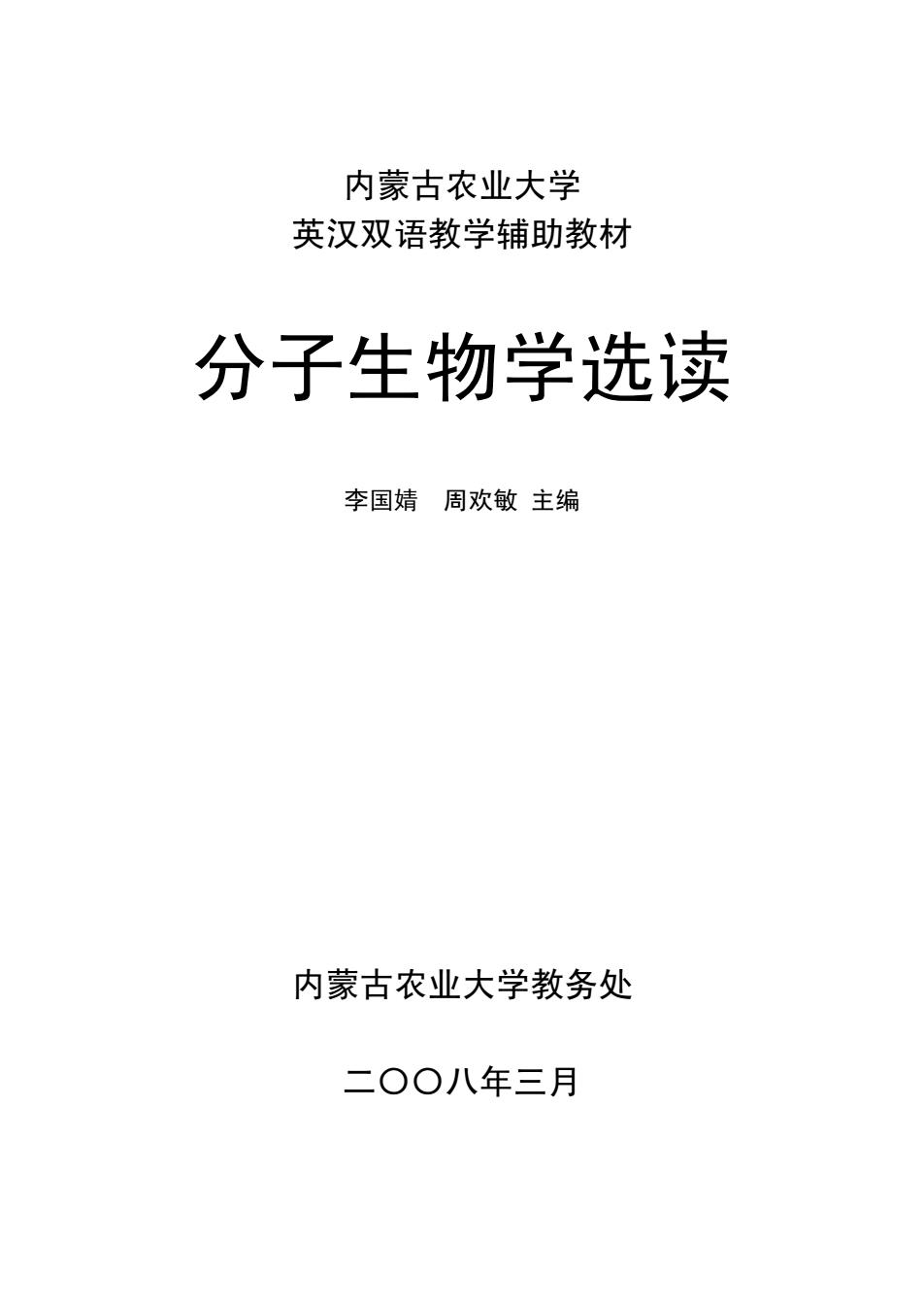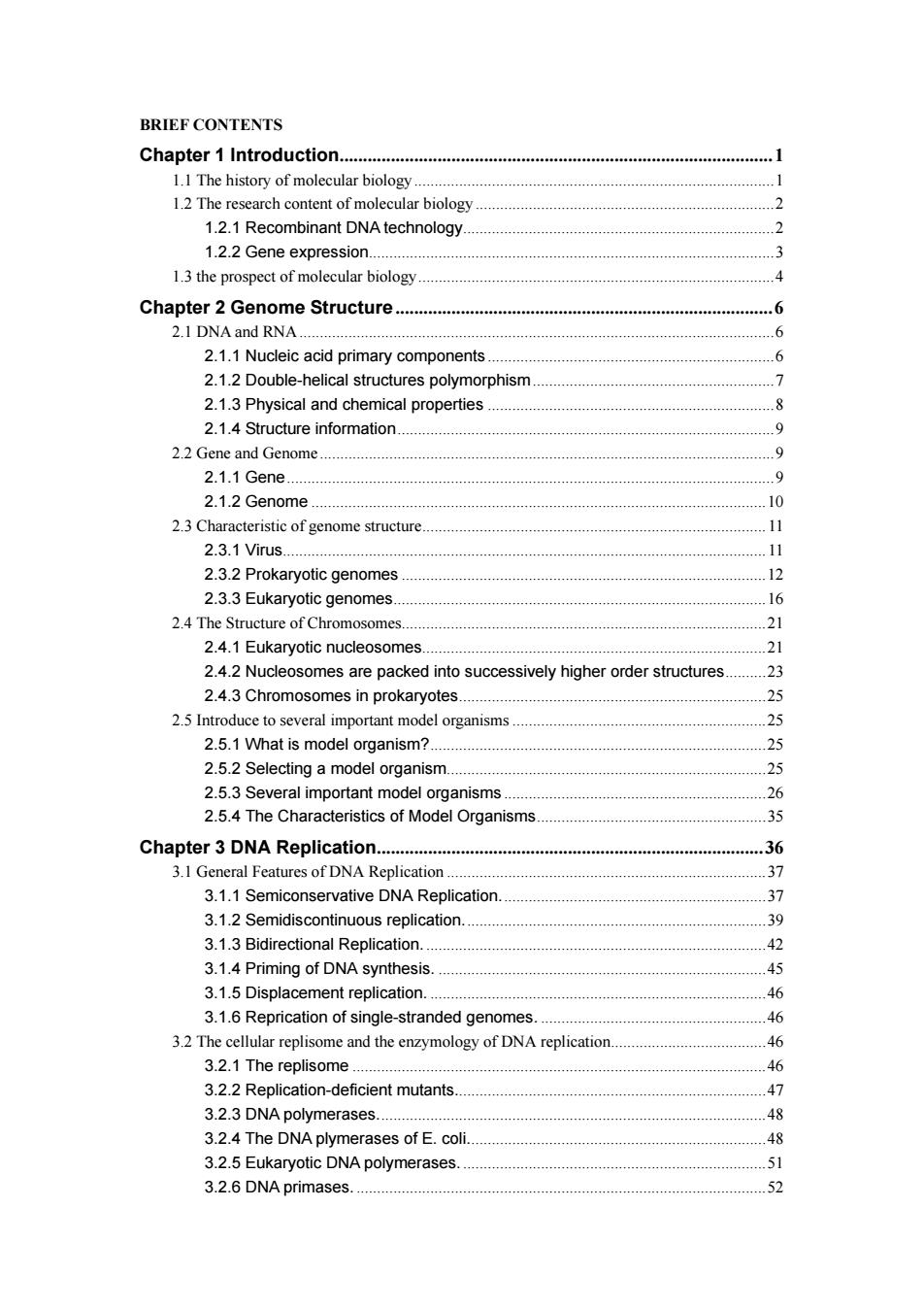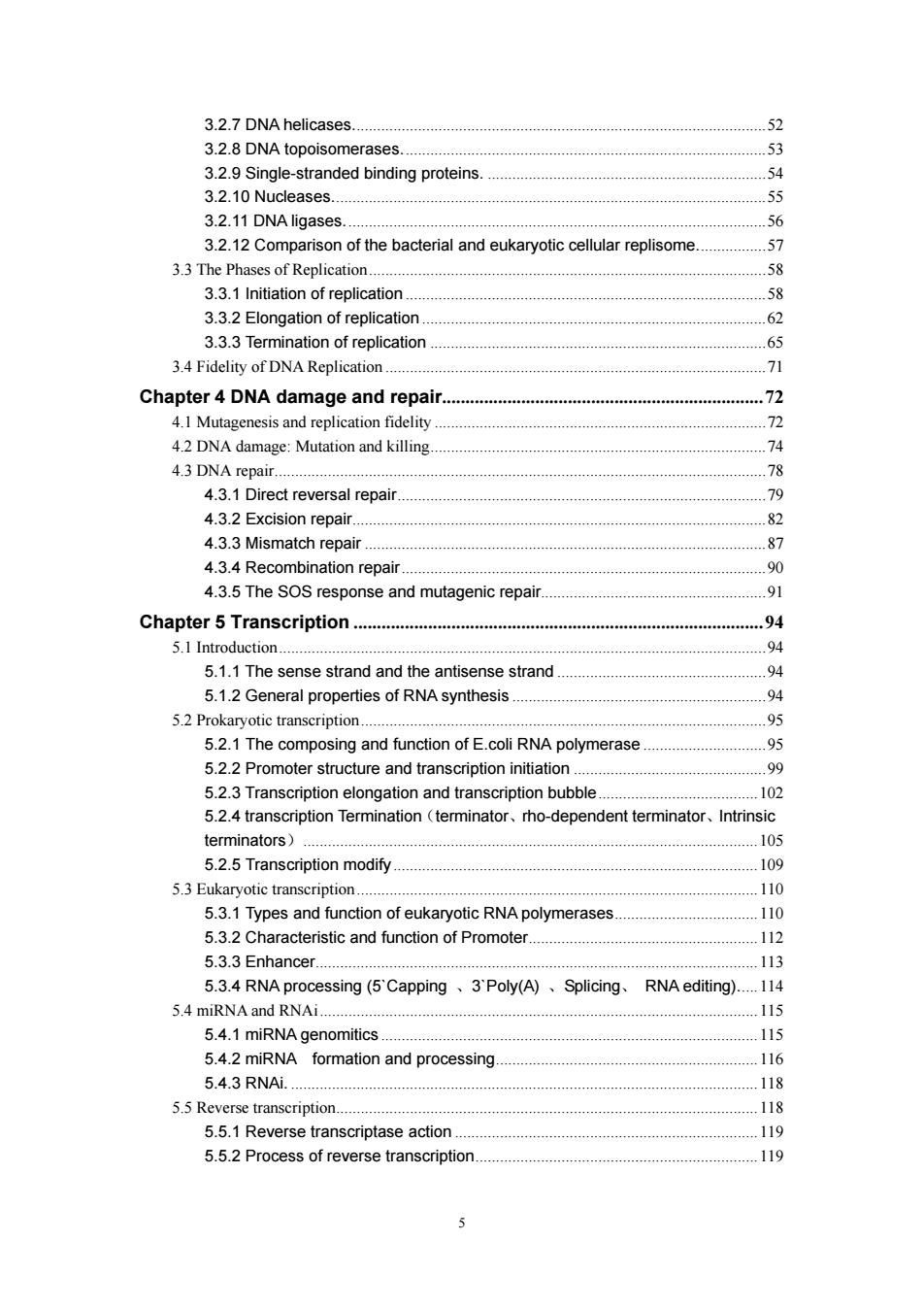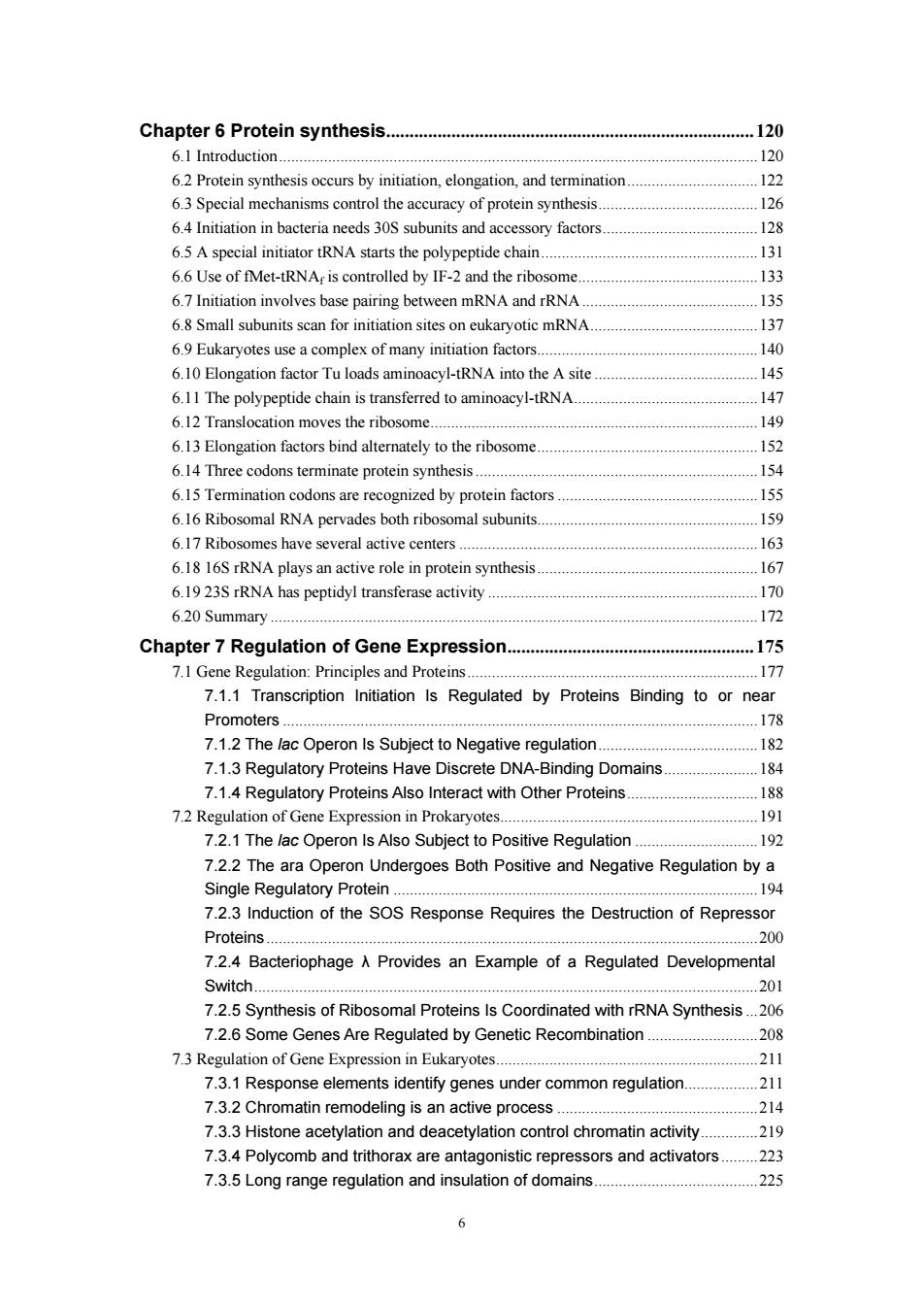
内蒙古农业大学 英汉双语教学辅助教材 分子生物学选读 李国婧周欢敏主编 内蒙古农业大学教务处 二OO八年三月
内蒙古农业大学 英汉双语教学辅助教材 分子生物学选读 李国婧 周欢敏 主编 内蒙古农业大学教务处 二〇〇八年三月

BRIEF CONTENTS Chapter 1 Introduction. 11 The history of molecular biology 1 2 The res rch content of molecular biolog 1.2.1 Recombinant DNA technology 1.2.2 Gene expression. 1.3 the prospect of molecular biology Chapter 2 Genome Structure. 6 2.1 DNA and RNA. .6 2.1.1 Nucleic acid primary components. 6 2.1.2 Double-helical structures polymorphism. 7 2.1.3 Physical and che ical properties Q 2.1.4 Structure information 2.2 Gene and Genome. 2.1.1 Gene 9 2 1 2 Genome 10 23Characteristic of genome structur 11 2.3.1Virus 2.3.2 Prokaryotic genomes. 2.3.3 Eukarvotic genomes. .16 2 4 The Structure of chromosomes 21 2.4.1 Eukaryotic nucleosomes 1 2.4.2 Nuceosomes are packed into successively higher order structures 23 2.4.3 Chromosomes in prokaryotes. 2.5 Introduce to several important model organisms. .25 2.5.1 What is model organism?. 25 2.5.2 Selecting a model organism 75 2.5.3 Several imp tant 2.5.4 The Characteristics of 35 Chapter 3 DNA Replication 31。 atures of DNA Rep licatior 37 37 3.1.2 Semidiscontinuous replication. .39 3 1 3 Bidirectional replication 42 3.1.4 Priming of DNA synthesis. 3.1.5 Displa 46 3.1.6 Reprication of single-stranded genomes 3.2 The cellular replisome and the enzymology of DNA replication. .46 3.2.1 The replisome 46 3.2.2 Replication-deficient mutants. 47 3.2.3 DNApolymerases 48 3.2.4 The DNAplymerases of E.coli .48 3.2.5 Eukaryotic DNA polymerases. .5 3.2.6 DNA primases. .52
BRIEF CONTENTS Chapter 1 Introduction.1 1.1 The history of molecular biology.1 1.2 The research content of molecular biology .2 1.2.1 Recombinant DNA technology.2 1.2.2 Gene expression.3 1.3 the prospect of molecular biology.4 Chapter 2 Genome Structure .6 2.1 DNA and RNA .6 2.1.1 Nucleic acid primary components .6 2.1.2 Double-helical structures polymorphism.7 2.1.3 Physical and chemical properties .8 2.1.4 Structure information.9 2.2 Gene and Genome.9 2.1.1 Gene.9 2.1.2 Genome .10 2.3 Characteristic of genome structure.11 2.3.1 Virus.11 2.3.2 Prokaryotic genomes .12 2.3.3 Eukaryotic genomes.16 2.4 The Structure of Chromosomes.21 2.4.1 Eukaryotic nucleosomes.21 2.4.2 Nucleosomes are packed into successively higher order structures.23 2.4.3 Chromosomes in prokaryotes.25 2.5 Introduce to several important model organisms .25 2.5.1 What is model organism?.25 2.5.2 Selecting a model organism.25 2.5.3 Several important model organisms .26 2.5.4 The Characteristics of Model Organisms.35 Chapter 3 DNA Replication.36 3.1 General Features of DNA Replication .37 3.1.1 Semiconservative DNA Replication.37 3.1.2 Semidiscontinuous replication.39 3.1.3 Bidirectional Replication. .42 3.1.4 Priming of DNA synthesis. .45 3.1.5 Displacement replication. .46 3.1.6 Reprication of single-stranded genomes. .46 3.2 The cellular replisome and the enzymology of DNA replication.46 3.2.1 The replisome .46 3.2.2 Replication-deficient mutants.47 3.2.3 DNA polymerases.48 3.2.4 The DNA plymerases of E. coli.48 3.2.5 Eukaryotic DNA polymerases.51 3.2.6 DNA primases. .52

32 7 DNA helicases 52 3.2.8 DNA topoisomerases. 53 3.2.9Single-stra nded binding proteins 32.10N ases 3.2.11 DNA ligases. 3.2.12 Comparison of the bacterial and eukarvotic cellular replisome. 57 33 The Phases of Replication. 58 3.3.1 Initiation of replication 3.3.2 Elongation of replication 62 3.3.3 Termination of replication 6 3.4 Fidelity of DNA Replication. .71 Chapter 4 DNA damage and repair 72 4.1 Mutagenesis and replication fidelity 72 4.2 DNA damage:Mutation and killing 74 4.3 DNA repair. 7 4.3.1 irect reversal repair 70 4.3.2 Excision repair .82 4.3.3 Mismatch repair. .87 4.3.4 Recombination repair. 90 4.3.5 The SOS response and mutagenic repair 01 Chapter 5 Transcription. 94 5.1 Introduction. 04 5.1.1 The sense strand and the antisense strand 04 5.1.2 General properties of RNA synthesis. 5.2 Prokaryotic transcription. .95 5.2.1 The composing and function of E.coli RNA polymerase .95 5.2.2 Promoter structure and transcription initiation 5.2.3 Transcription elongation and transcription bubble 102 5 2 4 tra iption Ter ator hn depen inator.Intrinsic terminators) 5.2.5 Transcription modify ,.109 5 3 Eukarvotic transcription 110 5.3.1 Types and function of eukaryotic RNA polymerases 110 5.3.2 Characteristic and function of Promote 112 5.3.3 Enhancer 5.3.4 RNA processing (5 Capping,3'Poly(A)Splicing.RNA editing).114 5.4 miRNA and RNAi. ,115 5 4 1 miRNA genomitics 115 5.4.2 miRNA formation and processing 116 5.4.3RNAi. 118 5.5 Reverse transcription. 5.5.1 Reverse transcriptase action. 119 5.5.2 Process of reverse transcription. .119
5 3.2.7 DNA helicases.52 3.2.8 DNA topoisomerases.53 3.2.9 Single-stranded binding proteins. .54 3.2.10 Nucleases.55 3.2.11 DNA ligases.56 3.2.12 Comparison of the bacterial and eukaryotic cellular replisome.57 3.3 The Phases of Replication.58 3.3.1 Initiation of replication .58 3.3.2 Elongation of replication .62 3.3.3 Termination of replication .65 3.4 Fidelity of DNA Replication .71 Chapter 4 DNA damage and repair.72 4.1 Mutagenesis and replication fidelity .72 4.2 DNA damage: Mutation and killing.74 4.3 DNA repair.78 4.3.1 Direct reversal repair.79 4.3.2 Excision repair.82 4.3.3 Mismatch repair .87 4.3.4 Recombination repair.90 4.3.5 The SOS response and mutagenic repair.91 Chapter 5 Transcription .94 5.1 Introduction.94 5.1.1 The sense strand and the antisense strand .94 5.1.2 General properties of RNA synthesis .94 5.2 Prokaryotic transcription.95 5.2.1 The composing and function of E.coli RNA polymerase .95 5.2.2 Promoter structure and transcription initiation .99 5.2.3 Transcription elongation and transcription bubble.102 5.2.4 transcription Termination(terminator、rho-dependent terminator、Intrinsic terminators).105 5.2.5 Transcription modify .109 5.3 Eukaryotic transcription.110 5.3.1 Types and function of eukaryotic RNA polymerases.110 5.3.2 Characteristic and function of Promoter.112 5.3.3 Enhancer.113 5.3.4 RNA processing (5`Capping 、3`Poly(A) 、Splicing、 RNA editing).114 5.4 miRNA and RNAi.115 5.4.1 miRNA genomitics .115 5.4.2 miRNA formation and processing.116 5.4.3 RNAi. .118 5.5 Reverse transcription.118 5.5.1 Reverse transcriptase action .119 5.5.2 Process of reverse transcription.119

Chapter 6 Protein synthesis 120 6 1 Introduction .120 6 2 Protein synthesis occurs by initiation elongation and termination 122 6 3 Special mechanisms control the ac otein synthesis 126 accessory factors 128 6.5A special initiator tRNA starts the polypeptide chair 6.6 Use of fMet-tRNAr is controlled by IF-2 and the ribosome. 133 6.7 Initiation involves base pairing between mRNA and rRNA. .135 6.8 Small subunits scan for initiation sites on eukaryotic mRNA 137 Eukaryo ea co 140 6.10 Elongation factor Tu loads aminoacyl-tRNA into the A site 6.11 The polypeptide chain is transferred to aminoacyl-tRNA. .147 6 12 Translocation moves the ribosome 149 6.13 Elongation factors bind alternately to the ribosome 152 codons terminate protein synthesis 154 codons are recog nized by protein factors 6.16 Ribosomal RNA pervades both ribosomal subunits 13 6.17 Ribosomes have several active centers 163 6.18 16S rRNA plays an active role in protein synthesis 167 6.1923rRNA has peptidyl transferase activity 170 6.20 Summary. .12 Chapter 7 Regulation of Gene Expression 175 7.1Gene Regulatior inciples and Pr 17 7.1.1 Transcription Initiation Is Regulated by Proteins Binding to or nea Promoters. .178 7.1.2 The lac Operon Is Subject to Negative regulation. 182 7.1.3 Regulatory Proteins Have Discrete DNA-Binding Domains 184 7.1.4Reg Proteins Also Inte eract with Other Proteins 9 7.2.1 The lac Operon Is Also Subject to Positive Regulation 192 7.2.2 The ara Operon Undergoes Both Positive and Negative Regulation by a Single Regulatory Protein. 194 7.2.3 Induction of the SOS Response Requires the Destruction of Repressor Prot ins 10 7.2.4 Bacteriophage Provides an Example of a Regulated Developmental Switch. .201 7.2.5 Synthesis of Ribosomal Proteins Is Coordinated with rRNA Synthesis.206 7.2.6 Some genes are reaulated by genetic Recombination 208 73 Regulation of Gene Expression in Eukaryote 211 esponse elements ide ntify genes under common regulatior .211 7.3.2 Chromatin remodeling is an active process. .214 7.3.3 Histone acetylation and deacetylation control chromatin activity. .219 7.3.4 Polycomb and trithorax are antagonistic repressors and activators. 223 7.3.5 Long range regulation and insulation of dom ains 225
6 Chapter 6 Protein synthesis.120 6.1 Introduction.120 6.2 Protein synthesis occurs by initiation, elongation, and termination.122 6.3 Special mechanisms control the accuracy of protein synthesis.126 6.4 Initiation in bacteria needs 30S subunits and accessory factors.128 6.5 A special initiator tRNA starts the polypeptide chain.131 6.6 Use of fMet-tRNAf is controlled by IF-2 and the ribosome.133 6.7 Initiation involves base pairing between mRNA and rRNA.135 6.8 Small subunits scan for initiation sites on eukaryotic mRNA.137 6.9 Eukaryotes use a complex of many initiation factors.140 6.10 Elongation factor Tu loads aminoacyl-tRNA into the A site .145 6.11 The polypeptide chain is transferred to aminoacyl-tRNA.147 6.12 Translocation moves the ribosome.149 6.13 Elongation factors bind alternately to the ribosome.152 6.14 Three codons terminate protein synthesis .154 6.15 Termination codons are recognized by protein factors .155 6.16 Ribosomal RNA pervades both ribosomal subunits.159 6.17 Ribosomes have several active centers .163 6.18 16S rRNA plays an active role in protein synthesis.167 6.19 23S rRNA has peptidyl transferase activity .170 6.20 Summary .172 Chapter 7 Regulation of Gene Expression.175 7.1 Gene Regulation: Principles and Proteins.177 7.1.1 Transcription Initiation Is Regulated by Proteins Binding to or near Promoters .178 7.1.2 The lac Operon Is Subject to Negative regulation.182 7.1.3 Regulatory Proteins Have Discrete DNA-Binding Domains.184 7.1.4 Regulatory Proteins Also Interact with Other Proteins.188 7.2 Regulation of Gene Expression in Prokaryotes.191 7.2.1 The lac Operon Is Also Subject to Positive Regulation .192 7.2.2 The ara Operon Undergoes Both Positive and Negative Regulation by a Single Regulatory Protein .194 7.2.3 Induction of the SOS Response Requires the Destruction of Repressor Proteins.200 7.2.4 Bacteriophage λ Provides an Example of a Regulated Developmental Switch.201 7.2.5 Synthesis of Ribosomal Proteins Is Coordinated with rRNA Synthesis .206 7.2.6 Some Genes Are Regulated by Genetic Recombination .208 7.3 Regulation of Gene Expression in Eukaryotes.211 7.3.1 Response elements identify genes under common regulation.211 7.3.2 Chromatin remodeling is an active process .214 7.3.3 Histone acetylation and deacetylation control chromatin activity.219 7.3.4 Polycomb and trithorax are antagonistic repressors and activators.223 7.3.5 Long range regulation and insulation of domains.225

Chapter 8 The hot topics of genomics,and the Post-Genome Era.233 8.1 The Human Genome Proiect(HGP). .233 8.1.1 HGP progress and goal 233 8.1.2 Four map. )14 8.1.3 Shotgun sequencing 236 8 Comparative genomics. .237 8.2.1 Content. .237 8.2.2 Many organisms have almost similar gene. .237 8.3 Functional genomics. 238 8.3.1 Transcriptome 730 8.3.2 Proteomics 240 8.3.3 Metabolomics 241 84 HapMap 241 8.4.1 contents and significance 241 8.4.2 Progress. 344 5 Microbial genome sequencing project .24 Chapter 9 Genetic engineering technology .245 to gen tic engineering. 245 9.1.1 Definition of genetic engineering. 24 9.1.2 A History of genetic engineering. 246 9.1.3 The safety analysis of Genetic engineering. 246 9.2 General technology of genetic engineering GG 247 92 1 Nucleic 247 atior 5 9.2.3 Polymerase chain reaction(PCR) 254 9.2.4 DNA sequencing technology. 260 9.2.5 DNA chip. 264 9 3 genetic engine ing en☑y 365 9.3.1 DNA poly 265 9.3.2 DNA modified enzyme 9.3.3 Exonucleases. .270 9.3.4 Endonuclease 270 9.3.5 DNA ligase. 170 94g g ectors 273 9.4.2 Phage vector .278 9.5 Cloning strategy. .280 95 1 Genomic Cloning 281 9.5.2 cDNA Cloning. 7g3 9.6.1 recombinant into host cell by cloning. 28 9.6.2 Screening strategy 287
7 Chapter 8 The hot topics of genomics, and the Post-Genome Era.233 8.1 The Human Genome Project(HGP) .233 8.1.1 HGP progress and goal .233 8.1.2 Four map.234 8.1.3 Shotgun sequencing .236 8.2 Comparative genomics.237 8.2.1 Content.237 8.2.2 Many organisms have almost similar gene .237 8.3 Functional genomics .238 8.3.1 Transcriptome .239 8.3.2 Proteomics.240 8.3.3 Metabolomics .241 8.4 HapMap.241 8.4.1 contents and significance.241 8.4.2 Progress.244 8.5 Microbial genome sequencing project .244 Chapter 9 Genetic engineering technology .245 9.1 Introduction to genetic engineering.245 9.1.1 Definition of genetic engineering.245 9.1.2 A History of genetic engineering.246 9.1.3 The safety analysis of Genetic engineering. .246 9.2 General technology of genetic engineering GG.247 9.2.1 Nucleic acid electrophoresis.247 9.2.2 Nucleic acid hybridization.251 9.2.3 Polymerase chain reaction (PCR).254 9.2.4 DNA sequencing technology.260 9.2.5 DNA chip.264 9.3 Genetic engineering enzymology.265 9.3.1 DNA polymerase.265 9.3.2 DNA modified enzyme .268 9.3.3 Exonucleases.270 9.3.4 Endonuclease. .270 9.3.5 DNA ligase.272 9.4 gene cloning vectors.273 9.4.1 plasmid.274 9.4.2 Phage vector .278 9.5 Cloning strategy .280 9.5.1 Genomic Cloning .281 9.5.2 cDNA Cloning.283 9.6 transformation and screening .285 9.6.1 recombinant into host cell by cloning.285 9.6.2 Screening strategy .287